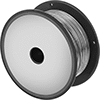Filter by
Material
For Joining
Attachment Type
Maximum Temperature
Appearance
Wire Rope Diameter
Specifications Met
DFARS Specialty Metals
Finish
Tolerance Rating
Wire Material
Cord Insulation Material
Raw Materials
Material Handling
Fastening and Joining
Measuring and Inspecting
Communication
Electrical
Heating, Ventilation, and Air Conditioning















































